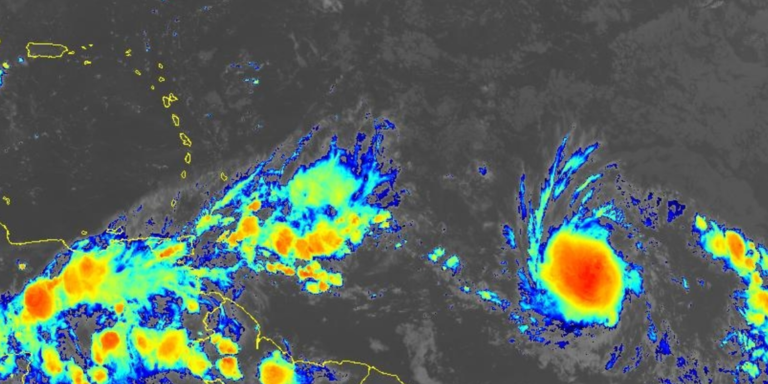Strengthening Tropical Storm Beryl poses hurricane threat to Windward Islands
The second named storm of the season, Tropical Storm Beryl, has formed, and the Windward Islands, especially Barbados and Grenada, should be on heightened hurricane alert.
Tropical Storm Beryl is rapidly intensifying in the central Atlantic, with at least one Caribbean island nation currently under a hurricane watch.
The National Hurricane Center (NHC) has been tracking the development of the system, previously known as Tropical Depression No. 2, over the past few days. Satellite imagery on Friday showed the system had developed enough to be classified as a tropical storm, and it is expected to become a hurricane by Saturday night or Sunday.
According to the NHC’s latest report, the cyclone’s maximum sustained winds were at least 50 mph. A cyclone is classified as a hurricane when sustained winds reach at least 74 mph.
Beryl is expected to be the first hurricane of the 2024 season, a statistic that is not usually reached until August 11th.
2024 Atlantic hurricane season guide: What you need to know about this year’s storms
Where is Tropical Storm Beryl?
Tropical Storm Beryl is located in the tropical Atlantic less than 1,000 miles east-southeast of the Windward Islands and does not pose an immediate threat to land within the next 24 hours.
On its current track, the cyclone is expected to affect the southern Windward Islands on Monday.
Where are the Lesser Antilles, Windward Islands, and Leeward Islands?
BERYL TRACKER: Live forecasts, tropical weather alerts, spaghetti models and more
What’s the forecast for Tropical Storm Beryl?
Tropical Storm Beryl continues to strengthen and is expected to quickly become a hurricane and impact the Caribbean.
A hurricane watch has been issued for Barbados, with further watches and warnings expected to be issued for the Windward Islands later Saturday.
The storm’s predicted path will put islands such as Barbados, Grenada, Saint Lucia, Martinique and Saint Vincent and the Grenadines directly affected.
The affected islands could experience tropical storm-force winds by Sunday, with hurricane-force winds possible by Sunday night or Monday morning, the NHC said.
Forecast models show wind speeds could reach more than 100 mph as the cyclone passes over several islands, possibly reaching nearly Category 3 on the Saffir-Simpson scale south of Puerto Rico.
“Typically, atmospheric conditions are unfavourable for intensification over this part of the Atlantic basin in late June. However, overall atmospheric and oceanic conditions appear to be trending towards a steady intensification over the next few days,” NHC forecasters said.
In addition to hurricane-force winds, heavy rains will drench islands, and current forecasts predict Beryl will bring 3 to 6 inches of rain to Barbados and the affected Windward Islands, causing localized flooding.
Strong swells from Beryl can cause life-threatening rough seas and undertows along the islands.
Will Beryl have an impact on the US?
The closest US territories to the storm are the US Virgin Islands and Puerto Rico, but neither are under a warning.
The FOX Forecast Center expects the main impacts to remain south of the islands, but the possibility of passing rain clouds cannot be ruled out.
It remains to be seen whether the hurricane will threaten the continental U.S., but if it does, it will likely be in a different form.
“For now, it looks like high pressure over the southeastern U.S. will likely keep Beryl pretty far south, at least into the Caribbean,” said Brian Norcross, a hurricane expert with Fox Weather. “But it’s too early to say what the long-term outlook will be. Forecasting systems that aren’t yet developing, or that are essentially forming, has a much larger margin of error than forecasting a developed storm.”
Why the Eastern Caribbean is known as the “hurricane graveyard”
Tracking a disturbance east of Beryl and Invest 94L around Central America.
A disturbance several hundred miles east of Beryl is producing heavy showers and thunderstorms.
The system may develop slowly into early next week as it moves generally westward across the central and western tropical Atlantic at 15 to 20 miles per hour, according to the NHC.
Its chances of development over the next week are currently moderate, and it may follow a similar trajectory to Beryl.
How do hurricanes form?
Another disturbance, dubbed Invest 94L, is moving through the Caribbean Sea toward Central America and southern Mexico, bringing heavy rains.
The NHC has given the system a medium chance of developing, and if it does develop, it would likely be located in the westernmost Caribbean Sea or southernmost Gulf of Mexico if it survives across land, Norcross said.
“The current schedule calls for this disturbance to impact Central America and then move into the southern Gulf of Mexico over the weekend,” Norcross explained. “High pressure over the southern U.S. should keep the disturbance south.”

